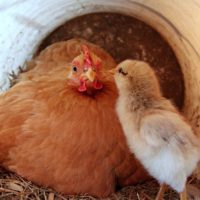My friend’s rabbit had baby bunnies a few months back. Ten bunnies, to be exact.
They were a surprise—she thought she’d neutered the father in time—and then one morning we learned that rabbits really are as fertile as people say. We cooed over the jellybean-shaped babies, some covered in fur, others more pink-skinned.
Over the next two days, five bunnies died despite best efforts to provide appropriate shelter and despite knowing that the mother was indeed nursing them in the night.
My friend told me about the first two deaths, but it wasn’t until I visited her several days later that she whispered three more had passed. Her face was stricken with guilt and shame.
And so I shared with her my baby chick story. It is not a story I like to share, because it, too, fills me with guilt and shame.
One of my chickens went broody last year. She wouldn’t eat or drink—she was determined to sit on the nest and hatch the eggs that the other hens had laid. She was being a good mother. Her comb went from red to pink—a sign of malnutrition. I threw in a handful of her favorite dried mealworms to get her to eat something, anything.
I tried to rid her of her broodiness—separating her from the nest box and other tricks to break a hen of broodiness. Her broodiness was for naught; she was sitting on unfertilized eggs, because I have no rooster.
Someone told me to sneak a fertilized egg under her—“That way when the egg hatches, she’ll finally stop being broody. And you get baby chicks!” So, I got a hold of a fertilized egg.
In three weeks, the egg hatched. It was an amazing thing to see—a chick making its way into the world. It was yellow with a brown racing stripe down its head and back. We cooed. We stared. We were amazed.
Then, the broody hen began pecking at the chick. The other hens pecked at the chick. I found the baby chick bloody, eyeless and broken but still alive, hours later.
What to do? The baby chick was clearly not going to survive. It was destined to a couple days’ suffering. I picked it up, staring at it, growing more nauseous by the minute.
I had to put it out of its misery.
Killing an animal is something I never thought myself capable of. Killing a baby animal felt impossible. I won’t tell you how I did it, only that I did. And that I buried it.
I told my friend that story. “Animal husbandry is no joke,” I added.
Later, I heard the baby chick story was the turning point to her finding peace in her animals’ death.
This May, we’re publishing a series of pieces focused on “Mothering outside the Margins.” Through these essays, reviews, interviews, stories, and poems, we aim to broaden our understanding of what it means to be a mother—or not to be a mother, or to want to be a mother but fall short of cultural ideals around motherhood.
The stories no one else shares.
The stories that bely myth.
The stories that help us forgive and heal.
The stories that show us how complicated and messy it is to be a mother to another human being.
I read 562 essay submissions. Included were stories of miscarriages, of women fighting to become mothers, of mothers of sick children, of grieving mothers, of women who can’t become mothers, of women who don’t want to be mothers.
We celebrate and salute these messy, inclusive, complicated tales of mothering. I hope they expand and heal your hearts, as they did mine. And, we hope you will follow along throughout the month, and share these pieces on Facebook and Twitter with the hashtag #mothering2018.
(My friend’s remaining five bunnies, by the way, are doing wonderful.)
***
Featured image via Creative Commons.




